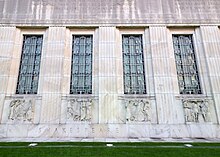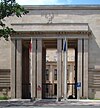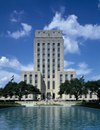Stripped Classicism

Stripped Classicism (or "Starved Classicism" or "Grecian Moderne")
Despite its etymological similarity, Stripped Classicism is sometimes distinguished from "Starved Classicism", the latter "displaying little feeling for rules, proportions, details, and finesse, and lacking all verve and élan".[5][7] At other times the terms "stripped" and "starved" are used interchangeably.[8][9]
Stripped Classicism was a materialistic manifestation of 'political' modernism. Recent historiography has explicitly linked this architectural style – and its relationship with modernist thinking – to political projects arising in the 1920–1930s, which utilised artistic dexterity to articulate – in built form – a powerful political ethos orientated towards the future.[10]
Other writers have noted the need to read the impact of avant-garde movements such as the
Description and history
Though the term is usually reserved for the more thorough style that forms part of 20th-century
Between the World Wars, a stripped-down classicism became the de facto standard for many monumental and institutional governmental buildings all over the world.[2] Governments used this architectural méthode to straddle modernism and classicism, an ideal political response to a modernizing world.[12] In part, this movement was said to have origins in the need to save money in governmental works by eschewing the expense of hand-worked classical detail.[6]

In Europe, examples as early as the
Among American architects, the work of
It is sometimes evident in buildings that were constructed by the
The movement was widespread, and transcended national boundaries. Architects who at least notably experimented in Stripped Classicism included John James Burnet, Giorgio Grassi, Léon Krier, Aldo Rossi, Albert Speer, Robert A. M. Stern and Paul Troost.[C][5]
Despite its popularity with
After the defeat of
The paradoxical embrace of old and new
The use of culture and 'myth' was a shared peculiarity of totalitarian political programmes during the 1920–30s, including
Through architecture, they strove to invoke the power of modernity in their physical landscapes (especially in their capital cities) and, simultaneously, reinvent the past (as symbolised by Stripped Classicism's restrained classical features) by ransacking its archetypal 'healthy' elements to inaugurate a reforged, rejuvenated, futural, open-ended and monumental future.
It is this curious dichotomy between old and new, an inexorable feature of Stripped Classicism, which historian Roger Griffin has encapsulated in his conceptual framework of 'rooted modernism' (which he discusses in relation to fascist buildings).[24]
The modernism in Stripped Classical buildings can be seen through their stylistic components (mute apertures, blank walls and the absence of ornament) and through their pure functionality. Adolf Loos, an Austrian theorist of modern architecture, and his essay "Ornament and Crime" can be seen as just one of the many philosophers/theorists/architects who foreshadowed some of the stylistic elements of Stripped Classicism.
Avant-garde movements such as Futurism also foreshadowed a form of building which is as much extravagant as it is streamlined, as much multi-functional as it is fit for the multi-faceted modern future vis-a-vis high-speed travel, technologically advanced means of communication, hydraulic engineering etc... "all in time for the most mechanised war in history", as Samuel Patterson writes.[25]
The Stripped Classical style was also embraced by Franklin D. Roosevelt, who yearned for an architecture symbolising a 'new beginning' under New Dealism (which was fighting to ameliorate the ramifications of the Great Depression), and concomitantly, archetypal American genius. A discussion of the Roosevelt administration, its reinvention of the past (centred on Jeffersonianism) and its uses of architecture in the 1930s can be found in Patterson's 'Problem-Solvers' thesis.[25]
Notable examples
See also
- Boris Iofan
- Constructivist architecture
- Dulwich Picture Gallery and Mausoleum[5]
- Giuseppe Terragni
- Nazi architecture
- Nordic Classicism
- Stalinist architecture
- Stile Littorio
Notes
- inter-war period. It is best defined as a pared down version of classicism that blended the classical vocabulary with the ever-growing desire for abstraction... Due to its strong associations with totalitarian governments, it is often excluded from the canonic historical narrative of the modern movement. Recently a growing number of scholars have begun to question the traditional definition of modern architecture. If the discussion on modernism is expanding beyond the traditional canonical definition, a greater understanding of Stripped Classicism's place amongst the modern movement can be achieved."[2]
- ^ Thus, for example, cuts might be substituted for moldings.[5]
- ^ German architect and husband of architect Gerdy Troost[5]
Citations
- ^ S2CID 164151091. Jstor (subscription required)
- ^ a b c d e Bryant 2011.
- ISBN 1579582435.
- ^ "Stripped Classical 1900-1945". Essential Architecture. Retrieved December 5, 2014.
- ^ a b c d e f g h Curl, James Stevens (2000). "Stripped Classicism". A Dictionary of Architecture and Landscape Architecture. Encyclopedia.com. Retrieved December 6, 2014.
- ^ a b c d e "Post War Stripped Classical". Archipaedia-archive. Archipaedia world architecture. November 23, 2009. Retrieved December 6, 2014.
- ^ Cf, Curl, James Stevens (2000). "Starved Classicism". A Dictionary of Architecture and Landscape Architecture. Encyclopedia.com. Retrieved December 6, 2014.
- ^ "Return To Classicism". chicagotribune.com. June 9, 1985. Retrieved April 18, 2018.
- ^ "Frist Center for the Arts, former US Post Office in Nashville". wordpress.com. October 4, 2015. Retrieved April 18, 2018.
- ^ Patterson, Samuel, "'Problem-Solvers': The Modernist Ethos Behind Architecture in Stalinist Russia and New Deal America"[1], 2019.
- ^ Patterson,"'Problem-Solvers'"[2], 2019.
- ^ Bryant 2011, p. 5.
- ISBN 1900639289. Retrieved December 5, 2014.
- ^ "Fascist Stripped Classical (German)". Essential Architecture. Retrieved December 5, 2014.
- ^ a b tjaaf (November 24, 2009). "Stalinist Architecture- Regional varieties". Archipaedia-archive. Archipaedia world architecture. Retrieved December 6, 2014.
- ^ a b Rybczynski, Witold (October 21, 2014). "The Late, Great Paul Cret". The New York Times. Retrieved December 5, 2014.
- ISBN 978-1421402703.
- ISBN 1568330081.
- ^ Prosser, Daniel (1992). The New Deal Builds: Government Architecture during the New Deal. Vol. 9. pp. 40–54.
{{cite book}}:|work=ignored (help) - ISBN 9780876632574.
- ^ "Stripped Classical". Archipaedia-archive. Archipaedia world architecture. November 23, 2009. Retrieved December 6, 2014.
- ^ "Fascist Stripped Classical (German)". Archipaedia-archiv. Archipaedia world architecture. November 24, 2009. Retrieved December 6, 2014.
- ^ "Late twentieth century Stripped Classical". Retrieved December 6, 2014.
- ^ Griffin, Roger [3], 2018.
- ^ a b Patterson,[4], 2019.
- Federal Reserve Board. Archived from the originalon June 12, 2002. Retrieved December 6, 2014.
- JSTOR 3525687.
- ^ "Find a Building: Search". www.gsa.gov. Retrieved April 18, 2018.
- ISBN 9781875891160.
Sources
- Bryant, Brittany Paige (June 2011). Reassessing Stripped Classicism within the Narrative of International Modernism in the 1920s–1930s (PDF) (MFA). The Savannah College of Art and Design. Retrieved January 4, 2024.






























